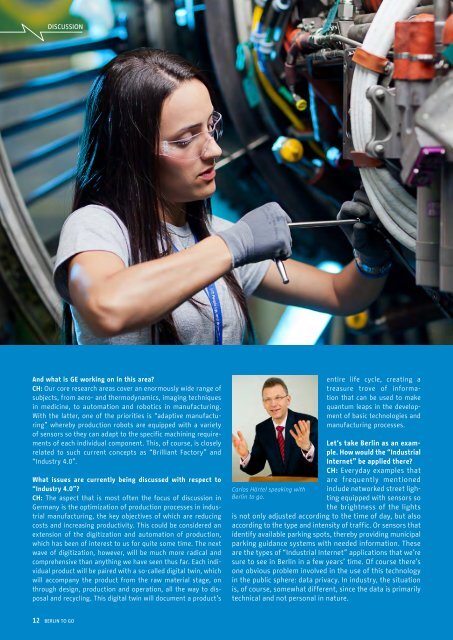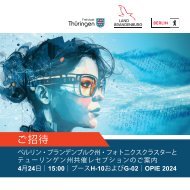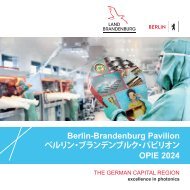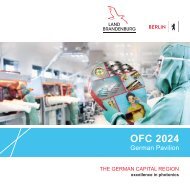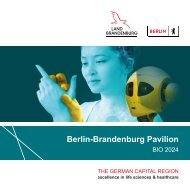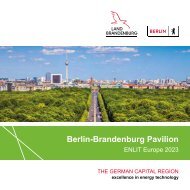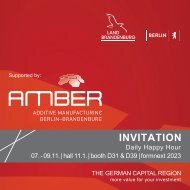Berlin to go, english edition 1/2015
You also want an ePaper? Increase the reach of your titles
YUMPU automatically turns print PDFs into web optimized ePapers that Google loves.
DISCUSSION<br />
And what is GE working on in this area?<br />
CH: Our core research areas cover an enormously wide range of<br />
subjects, from aero- and thermodynamics, imaging techniques<br />
in medicine, <strong>to</strong> au<strong>to</strong>mation and robotics in manufacturing.<br />
With the latter, one of the priorities is “adaptive manufacturing”<br />
whereby production robots are equipped with a variety<br />
of sensors so they can adapt <strong>to</strong> the specific machining requirements<br />
of each individual component. This, of course, is closely<br />
related <strong>to</strong> such current concepts as “Brilliant Fac<strong>to</strong>ry” and<br />
“Industry 4.0”.<br />
What issues are currently being discussed with respect <strong>to</strong><br />
“Industry 4.0”?<br />
CH: The aspect that is most often the focus of discussion in<br />
Germany is the optimization of production processes in industrial<br />
manufacturing, the key objectives of which are reducing<br />
costs and increasing productivity. This could be considered an<br />
extension of the digitization and au<strong>to</strong>mation of production,<br />
which has been of interest <strong>to</strong> us for quite some time. The next<br />
wave of digitization, however, will be much more radical and<br />
comprehensive than anything we have seen thus far. Each individual<br />
product will be paired with a so-called digital twin, which<br />
will accompany the product from the raw material stage, on<br />
through design, production and operation, all the way <strong>to</strong> disposal<br />
and recycling. This digital twin will document a product’s<br />
Carlos Härtel speaking with<br />
<strong>Berlin</strong> <strong>to</strong> <strong>go</strong>.<br />
entire life cycle, creating a<br />
treasure trove of information<br />
that can be used <strong>to</strong> make<br />
quantum leaps in the development<br />
of basic technologies and<br />
manufacturing processes.<br />
Let‘s take <strong>Berlin</strong> as an example.<br />
How would the “Industrial<br />
Internet” be applied there?<br />
CH: Everyday examples that<br />
are frequently mentioned<br />
include networked street lighting<br />
equipped with sensors so<br />
the brightness of the lights<br />
is not only adjusted according <strong>to</strong> the time of day, but also<br />
according <strong>to</strong> the type and intensity of traffic. Or sensors that<br />
identify available parking spots, thereby providing municipal<br />
parking guidance systems with needed information. These<br />
are the types of “Industrial Internet” applications that we’re<br />
sure <strong>to</strong> see in <strong>Berlin</strong> in a few years’ time. Of course there’s<br />
one obvious problem involved in the use of this technology<br />
in the public sphere: data privacy. In industry, the situation<br />
is, of course, somewhat different, since the data is primarily<br />
technical and not personal in nature.<br />
12 BERLIN TO GO


